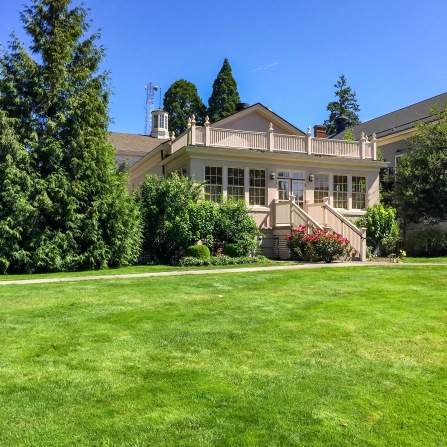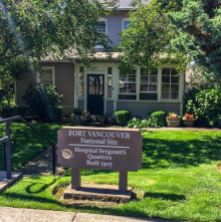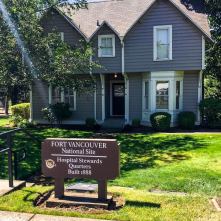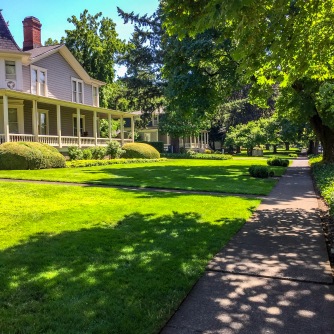This National Historic Site has a long history on the north bank of the Columbia River, starting as a Hudson Bay fur trading post. The Park is a collection of 4 distinct sites, Old Fort Vancouver, The Village, Pearson Air Field and Vancouver Barracks, each having a history of transition, settlement, manufacturing and conflict.
“Old Fort Vancouver”, visited before (LINK) which I will discussed more in a future post, was established around 1825 by the Hudson Bay Company. Serving as the main headquarters of the Company’s interior fur trade from Russian Alaska to Mexican California and everything west of the Rocky Mountains.

Reconstructed Old Fort Vancouver
“The Village” provided the area for housing the workers and their families who supported Fort Vancouver. Established in 1829 it had a population exceeding 600 and was one of the largest settlements in the west at that time.
“Pearson Air Field” first used the Polo Field of the Vancouver Barracks as a site for aviation enthusiasts to gather and show off their aerobatic skills in the early years of the 20th century. During World War I a Spruce Production Mill was built on the Polo Field to supply aviation grade lumber in the manufacturing of war planes. After the war the Spruce Mill was removed and “Vancouver Barracks Aerodrome” was built, in 1925 it was christened “Pearson Air Field,” after Lt. Alexander Pearson. I will go into more detail of this part of the Park in a future post.
Now on to my visit of “Vancouver Barracks”, the walk that morning was following the yellow marked path on the following map and included the walk down to the Columbia River on the previous post (LINK).

Know by many names throughout its history it has gone by Camp Vancouver (1849-1850), Columbia Barracks (1850-1853), Fort Vancouver (1853-1879), and finally Vancouver Barracks (1879 to present). One of the oldest military posts in the Pacific Northwest it was founded in 1849 by the U.S. Army.
During the Barracks history it has been a supply depot during the Civil War and Indian Wars. It later served as a recruitment and training facility for the Spanish American War, Philippine War and other engagements. World War I saw it used by the U.S. Army Signal Corps’ Spruce Production Division with the worlds largest lumber mill at that time. In 1925 the Army established it’s long history in aviation building Pearson Air Field. In the 1930’s Vancouver Barracks was the District Headquarters of the Civilian Conservation Corps (CCC). Finally when World War II broke out it served as the training center and staging area for the embarkation of troops leaving out of The Portland Sub-Port of Embarkation.
Reducing the Army’s presence after WW II portions of the post were transferred to the National Park Service and in 1948 was christened “The Fort Vancouver National Historic Site”. Many of the buildings are closed to the public although many informative plaques located in front of the buildings give a brief history of their use.
Commanded by many during its life, Vancouver Barracks has had some very notable men stationed here who attained the rank of general, including Ulysses S. Grant, Philip H. Sheridan, George B. McClellan, George Pickett, George Crook, Oliver O. Howard, Nelson Miles and George Marshall. In 1899 it was also the post for approximately 103 soldiers comprising Company B of the Twenty-fourth U.S. Infantry Regiment, The Buffalo Soldiers.
Onto the Vancouver Barracks site my walk started as I passed the South and West Barracks, turning left I pass the 1904 Artillery Barracks and the 1939 Non-Commissioned Officers (NCO) housing. The duplex NCO Quarters are lovely brick buildings to house the officers and their families.
I turn right on the next street passing the 1919 Red Cross Building that was constructed as a place returning injured veterans could remove themselves from the clinical hospital environment across the street while recuperating in the 1904 Post Hospital.
Passing the 1887 Infantry Barracks I turn right again to see the Hospital Sergeants Quarters and Hospital Stewards Quarters, both very lovely small homes for the use of these military personnel and their families.
Turning left I head toward the Parade Grounds with Infantry Barracks facing the large open expanse of land used for Military Parades and as a training area.
Across the street sits the O.O Howard House built in 1886, it became the posts Commanders Residence until 1934 when it was re-commissioned as a Non-Commissioned Officers Club until a fire in 1986. Considered one of the finest dwellings north of the Columbia River, the home hosted several notable guests including Ulysses S. Grant and President Rutherford B. Hayes.

O.O. Howard House
Strolling along the side of the Parade Grounds I arrive at Officers Row. Apart from the rest of the post it commanded a view all the way to the Columbia River across the Parade Grounds. Constructed as log cabins in the 1850’s the only surviving cabin is the Grant House that has been remodeled to fit in with the newer residences along the row. This was a remote assignment in the early years where few families could afford to live in such a remote location, later to became a vibrant social scene at the end of the 19th Century.
The Grant House was built in the 1850 as a 2-story log cabin for the Post Commanders Headquarters. Although Ulysses S. Grant never lived in this residence he was the Post’s Quartermaster from 1852 to 1853. Now a restaurant named “The Eatery at The Grant House” the early log structure is visible in several rooms. I didn’t eat there this visit but am planning on returning and sampling the fare.

Grant House on Officers Row
One of the few Officers Row structures that are not private is the Marshall House. This Queen Anne style house built between 1886 and 1887 was the residence of General John Gibbon and housed General George Marshall from 1936 to 1938. General Marshall is know for preparing the American Troops for the European Invasion during WW II, was the first to be given 5-star ranking, was Secretary of Stat while advocated rebuilding Europe after the war under his “Marshall Plan” and finally Secretary of Defense at the start of the Korean Conflict. Now used as a museum it is also rented out for functions and receptions.

Marshall House on Officers Row
Listed on the Register of National Historic Places, “Vancouver Barracks” provides an interesting way to spend an afternoon walking around the grounds. The large Parade Grounds and surrounding open areas are great places to sit under a tree and enjoy a picnic lunch. If you wish to spend the entire day in the Site visit the other locations of Old Fort Vancouver and Pearson Air Museum.




















Thank you for the excursion.
The Marshall House is just beautiful.
LikeLiked by 1 person
Beautiful.
LikeLiked by 1 person
Cool! We only had time to tour the fort when we were there. Didn’t see all the other stuff…
LikeLiked by 1 person
It’s a great place to spend a day seeing all the areas of the site.
LikeLiked by 1 person
Great post!
LikeLiked by 1 person